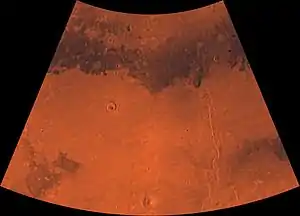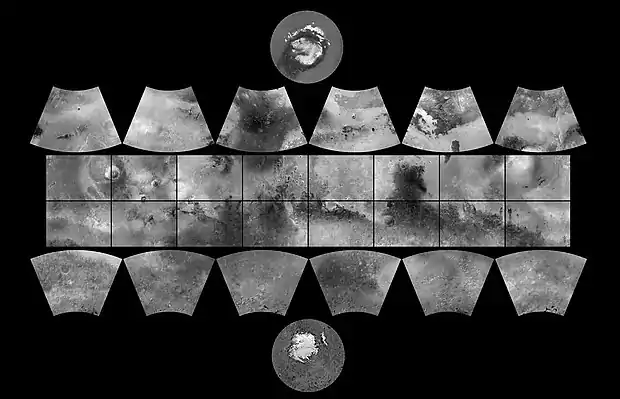Cebrenia (Gradfeld)
Das Cebrenia-Gradfeld gehört zu den 30 Gradfeldern des Mars. Sie wurden durch die United States Geological Survey (USGS) festgelegt. Die Nummer ist MC-7, das Gradfeld umfasst das Gebiet von 180° bis 240° westlicher Länge und von 30° bis 65° südlicher Breite.[1] Es enthält Teil von Utopia Planitia und Arcadia Planitia.

Bild des Cebrenia Gradfeldes. Der Nordwesten in relativ flach, der Südosten enthält Hecates Tholus und Phlegra Montes
Herkunft des Namens
Der Name kommt von einem Albedo feature im Bereich von 50° N and 150° E auf dem Mars, die Gegend wurde nach den Ebenen rund um das antike Troja benannt. Der Name wurde 1958 durch die Internationale Astronomische Union bestätigt.[2]
Geologie
Die bekanntesten Merkmale sind die großen Krater Mie und Stokes, Hecates Tholus, und die Berggruppe Phlegra Montes. Viking II landete am 3. September 1973 in der Nähe von Mie.[3]
Andere Gradfelder
Weblinks
Commons: Cebrenia – Sammlung von Bildern, Videos und Audiodateien
Einzelnachweise
- Davies, M.E.; Batson, R.M.; Wu, S.S.C. “Geodesy and Cartography” in Kieffer, H.H.; Jakosky, B.M.; Snyder, C.W.; Matthews, M.S., Eds. Mars. University of Arizona Press: Tucson, 1992.
- Cebrenia im Gazetteer of Planetary Nomenclature der IAU (WGPSN) / USGS
- Ezell E. K., Ezell L. N. On Mars: Exploration of the Red Planet. 1958–1978. (Chapter 10). The NASA History Series. Scientific and Technical Information Branch, 1984. NASA, Washington, D.C.
- Oliver Morton: Mapping Mars: Science, Imagination, and the Birth of a World. Picador USA, New York 2002, ISBN 0-312-24551-3, S. 98.
- PIA03467: The MGS MOC Wide Angle Map of Mars photojournal.jpl.nasa.gov, 16. Februar 2002
- Davies, M.E.; Batson, R.M.; Wu, S.S.C. "Geodesy and Cartography" in Kieffer, H.H.; Jakosky, B.M.; Snyder, C.W.; Matthews, M.S., Eds. Mars. University of Arizona Press: Tucson, 1992.
This article is issued from Wikipedia. The text is licensed under Creative Commons - Attribution - Sharealike. The authors of the article are listed here. Additional terms may apply for the media files, click on images to show image meta data.
